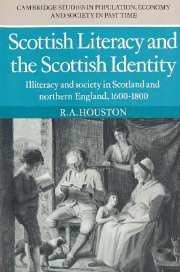 Scottish Literacy and the Scottish Identity
Scottish Literacy and the Scottish Identity Book contents
- Frontmatter
- Contents
- Tables
- Abbreviations
- Preface
- 1 The ideal of Scottish literacy
- 2 Structures and trends in illiteracy in the seventeenth and eighteenth centuries
- 3 Illiteracy in mid seventeenth-century Britain
- 4 The reasons for literacy
- 5 Measures of literacy
- 6 Oral culture and literate culture
- 7 The politics of literacy
- 8 Literacy and the Scottish identity
- Appendices
- Bibligraphy
- Index
3 - Illiteracy in mid seventeenth-century Britain
Published online by Cambridge University Press: 11 November 2009
- Frontmatter
- Contents
- Tables
- Abbreviations
- Preface
- 1 The ideal of Scottish literacy
- 2 Structures and trends in illiteracy in the seventeenth and eighteenth centuries
- 3 Illiteracy in mid seventeenth-century Britain
- 4 The reasons for literacy
- 5 Measures of literacy
- 6 Oral culture and literate culture
- 7 The politics of literacy
- 8 Literacy and the Scottish identity
- Appendices
- Bibligraphy
- Index
Summary
We have dealt in some detail with the period between the English Civil War and the onset of the Industrial Revolution in Britain. One aim of this book is to fill in gaps in our knowledge about this century. However, we cannot entirely ignore earlier times. As far as the decades between the accession of Elizabeth and the reign of Charles I are concerned the picture is relatively clear, at least for England. The important work of David Cressy has shown that the later sixteenth and early seventeenth centuries was an important period throughout England of substantially improving literacy for yeomen, and for craftsmen and tradesmen, but less so for women and the lower social ranks among men.
Of this earlier period there is unfortunately precious little we can say for Scotland. Sources are scanty and their reliability is open to question. Of 379 males who subscribed the 1581 Confession of Faith in the small town of Kinghorn in Fife, 84% were illiterate, as were all 414 women.2 Some patchy figures can be gleaned from the Justiciary Court 'Small Papers' – loose documents of the court – which suggest that levels of literacy among key groups were remarkably constant between the last quarter of the sixteenth century and the mid seventeenth century. Of twenty–nine craft and trade deponents at the Justiciary Court whose testimonies were subscribed between 1575 and 1660,48% were illiterate, and nine of eighteen for 1661-80. Many more depositions survive for this period, but most are innocent of any holograph subscription.
- Type
- Chapter
- Information
- Scottish Literacy and the Scottish IdentityIlliteracy and Society in Scotland and Northern England, 1600–1800, pp. 84 - 109Publisher: Cambridge University PressPrint publication year: 1985
